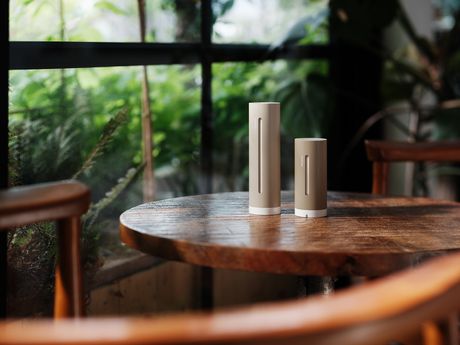
Netatmo onthult het nieuwe Weerstation ORIGINAL

Tot 50% korting op geselecteerde productenKopen

Zoals de naam al doet vermoeden, komt zonne-energie rechtstreeks van de zon. Om elektriciteit uit zonne-energie te produceren, maken fotovoltaïsche panelen (of zonnepanelen) of thermische zonne-energiecentrales gebruik van de warmte en het licht van de zon.
Sommige zonne-installaties en zonnepanelen produceren elektriciteit, andere produceren warm water (bv. zonneboilers), en weer andere installaties produceren beide.
Zonne-energie heeft vele voordelen:
Anderzijds is de fabricage van zonnepanelen niet helemaal schoon, aangezien zeldzame grondstoffen worden gebruikt en CO2 wordt uitgestoten tijdens het productieproces van de panelen. Van vervuiling is echter geen sprake meer vanaf het moment dat de installatie in gebruik wordt genomen!
Wist u dat zonne-energie ook de bron is van de meeste andere hernieuwbare energiebronnen? Het brengt de watermassa's in beweging voor blauwe energie, genereert de wind voor windenergie en ligt zelfs aan de oorsprong van de fotosynthese die biomassa en bepaalde koolwaterstoffen mogelijk maakt!
Om elektriciteit uit zonne-energie te produceren en zelf te gebruiken, worden gewoonlijk fotovoltaïsche panelen op een dak gemonteerd om zoveel mogelijk zonlicht op te vangen. Het hangt van de regio af, maar op sommige plaatsen in Nederland is het heel goed mogelijk een gevel of een tuin te kiezen voor een zonnepaneelinstallatie.
Technisch gezien zijn de fotovoltaïsche panelen verbonden met één of meer omvormer(s). Het doel van dit apparaat is de door het zonnetoestel geproduceerde gelijkstroom om te zetten in wisselstroom: dat wil zeggen hetzelfde als die van het conventionele elektriciteitsnet, dat thuis kan worden gebruikt.
Merk ook op dat een slimme meter, die geleidelijk in alle huishoudens wordt geïnstalleerd, de mogelijkheid biedt om zowel uw productie als uw verbruik van elektriciteit uit zonne-energie te meten.
Er zijn dus drie apparaten nodig om zonne-energie te produceren en te verbruiken: de fotovoltaïsche panelen, de omvormer en de elektriciteitsmeter.
Om verder te gaan in de energietransitie, uw elektriciteitsverbruik te verminderen en meer te besparen op uw rekening, kiest u voor de Slimme thermostaat van Netatmo. Met deze slimme thermostaat kunt u de temperatuur van elke kamer nauwkeurig regelen en programmeren, zelfs op afstand vanaf uw smartphone!
Zonne-energie uit fotovoltaïsche energie is aantoonbaar de schoonste, meest hernieuwbare en bovenal de meest overvloedige energiebron op aarde. Daarom past het gebruik ervan perfect in de zo broodnodige energietransitie. U kunt dus profiteren van financiële steun van de overheid voor de aanschaf van zonnepanelen, waardoor de prijs van deze investering aanzienlijk kan worden verlaagd.
Om van deze steun te kunnen profiteren bij de aankoop en het gebruik van een fotovoltaïsche zonne-installatie, is het echter van essentieel belang een beroep te doen op een gecertificeerde installateur.
Als u in een appartementencomplex woonachtig bent, kan de subsidieregeling Coöperatieve Energieopwekking voor u een interessante optie zijn. U investeert met de VvE (vereniging van eigenaren) in zonnewarmte tegen gunstige voorwaarden.
Er wordt namelijk een subsidiebedrag per opgewekte kWh uitgekeerd, over een periode van 15 jaar. Zo wordt een verwarmingssysteem op zonnewarmte een interessante optie voor appartementencomplexen en flats.
In het geval dat u op een bepaald moment meer zonne-energie opwekt dan u gebruikt is het mogelijk deze energie terug te leveren aan uw elektriciteitsleverancier. Dit proces wordt ook wel salderen genoemd, hierbij wordt de overtollige energie die u aan het elektriciteitsbedrijf teruglevert afgetrokken van uw elektriciteitsrekening. Op deze manier is het voor u als consument dus mogelijk geld te verdienen aan uw zelfopgewekte energie. Dit maakt de keuze om zonnepanelen te laten installeren nog aantrekkelijker, omdat dit een extra optie biedt uw investering zo snel mogelijk terug te verdienen.
Als u zonnepanelen installeert kunt ook profiteren van de regeling die het mogelijk maakt de BTW die u over de producten en de installatiewerkzaamheden heeft betaald volledig terug te vragen. Hiervoor volgt u drie simpele stappen: u verstuurt het ingevulde formulier ‘opgaaf zonnepaneelhouders’, u geeft uw rekeningnummer door en u vult tenslotte uw btw-aangifte in.
Voor de installatie van uw zonnepanelen maakt u naast de bekende subsidiemaatregelen wellicht ook aanspraak op lokale subsidies. Neem contact op met uw lokale overheid om hier meer over te weten te komen. Zij kunnen u het best informeren over alle financiële steun waarvoor uw zonnepanelen in aanmerking komen.
Zonne-energie is dus van nature een schone, hernieuwbare en overvloedig beschikbare energiebron die alleen maar voordelen heeft. Naast het verbruik van uw eigen 100% schone en hernieuwbare energie, kunt u nog meer geld besparen door overheidssteun aan te vragen voor uw fotovoltaïsche installatie. Wij staan aan de vooravond van de zonne-energie revolutie waarvan het potentieel nog grotendeels onbenut is!